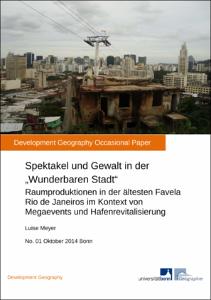Meyer, Luise: Spektakel und Gewalt in der „Wunderbaren Stadt“ : Raumproduktionen in der ältesten Favela Rio de Janeiros im Kontext von Megaevents und Hafenrevitalisierung. Bonn: Department of Geography, University of Bonn, 2014. In: Development Geography Occasional Paper, 01.
Online-Ausgabe in bonndoc: https://hdl.handle.net/20.500.11811/8577
Online-Ausgabe in bonndoc: https://hdl.handle.net/20.500.11811/8577
@techreport{handle:20.500.11811/8577,
author = {{Luise Meyer}},
title = {Spektakel und Gewalt in der „Wunderbaren Stadt“ : Raumproduktionen in der ältesten Favela Rio de Janeiros im Kontext von Megaevents und Hafenrevitalisierung},
publisher = {Department of Geography, University of Bonn},
year = 2014,
month = oct,
series = {Development Geography Occasional Paper},
volume = 01,
note = {Mega-events connect state agendas of image production with private sector's aspirations to valorise urban spaces. In the case of Rio de Janeiro mega-events may be scrutinised in the context of Brazil's rise to the league of global players as well as the worldwide growing importance of cities for economic growth, which comes along with interurban competition for attracting capital. By applying Henri Lefebvre's idea of a state mode of production as a tool of anylysis, this paper seeks to highlight state's role and strategies in organizing space for capitalist commodification and accumulation. The megaproject Porto Maravilha serves as a mechanism to create what Lefebvre calls abstract space, aiming to absorb and destroy all non-capitalist modes of production in the area. The favela upgrading project Morar Carioca and the so called Pacifying Police Units (UPP) must be seen in this context. Those spatial strategies of the state aim to control and hide social conflicts in order to attract investments and tourists. At the same time they have profound effects on people's everyday lives. Government policies can be disciplining, but they also can have an integrative or „social“ character. In any case they aim to adapt the space favela to the demands of capitalist markets. Emerging conflicts about Morar Carioca result in local practices of resistance and make the highly contested character of that spatial transformation obvious. Looking at the current production of space in Morro da Providência, the radically antagonistic interest of global capital, state actors and marginalized inhabitants of the area becomes evident. However, considering the historical development of the favela as a product of capitalist urban development, it becomes clear that current waves of evictions and displacement to the city's peripheries can be seen as an ongoing process of poor people's dispossession of rights and their subsequent exclusion from decision-making by the dominant elites.},
url = {https://hdl.handle.net/20.500.11811/8577}
}
author = {{Luise Meyer}},
title = {Spektakel und Gewalt in der „Wunderbaren Stadt“ : Raumproduktionen in der ältesten Favela Rio de Janeiros im Kontext von Megaevents und Hafenrevitalisierung},
publisher = {Department of Geography, University of Bonn},
year = 2014,
month = oct,
series = {Development Geography Occasional Paper},
volume = 01,
note = {Mega-events connect state agendas of image production with private sector's aspirations to valorise urban spaces. In the case of Rio de Janeiro mega-events may be scrutinised in the context of Brazil's rise to the league of global players as well as the worldwide growing importance of cities for economic growth, which comes along with interurban competition for attracting capital. By applying Henri Lefebvre's idea of a state mode of production as a tool of anylysis, this paper seeks to highlight state's role and strategies in organizing space for capitalist commodification and accumulation. The megaproject Porto Maravilha serves as a mechanism to create what Lefebvre calls abstract space, aiming to absorb and destroy all non-capitalist modes of production in the area. The favela upgrading project Morar Carioca and the so called Pacifying Police Units (UPP) must be seen in this context. Those spatial strategies of the state aim to control and hide social conflicts in order to attract investments and tourists. At the same time they have profound effects on people's everyday lives. Government policies can be disciplining, but they also can have an integrative or „social“ character. In any case they aim to adapt the space favela to the demands of capitalist markets. Emerging conflicts about Morar Carioca result in local practices of resistance and make the highly contested character of that spatial transformation obvious. Looking at the current production of space in Morro da Providência, the radically antagonistic interest of global capital, state actors and marginalized inhabitants of the area becomes evident. However, considering the historical development of the favela as a product of capitalist urban development, it becomes clear that current waves of evictions and displacement to the city's peripheries can be seen as an ongoing process of poor people's dispossession of rights and their subsequent exclusion from decision-making by the dominant elites.},
url = {https://hdl.handle.net/20.500.11811/8577}
}






